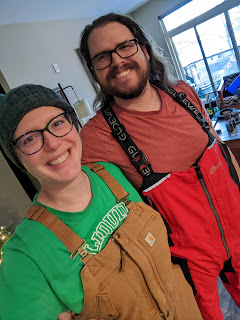There's so much to see and do in Rome that I'm splitting up the blog posts into the days we were here. Here's the first!
Our first night in Rome we discovered a tiny pizza shop near our apartment. Nobody spoke English and a constant stream of locals came in and out to pick up dinner so we know we found something truly authentic!
Our first full day, we went to scout out the Vatican and get tickets for the papal audience the next day (free!). St Peter's Basilica and Square are beautiful and enormous! Lots of sculptures and columns adorn the walls surrounding the Square. We also walked by the Castel Sant'Angelo: Hadrian's mausoleum turned papal fortress. There's a covered passageway connecting it to St Peter's!
 |
| Woo-hoo, Vatican! St Peter's Basilica in the background, we're in the Square here. |
 |
| Castel Sant'Angelo from the Tiber River. |
After our scouting trip, we walked down through some of the old streets surrounding the Vatican and towards all the other important ancient buildings of Rome. We first came across the Piazza Navona, a square built on the site of a Roman stadium from the 1st century AD. There are many famous sculptures and buildings in and around the square.
 |
| Fountain of Four Rivers in the square, created by Bernini. |
We then literally stumbled upon the Pantheon (I knew exactly where we were. -Wil), probably the best-preserved piece of Roman architecture. The Pantheon standing today was built in the early 2nd century, after the original building burned down twice. To this day, its dome is the world's largest non-reinforced concrete dome, and is the model for many domes that were built afterward (like the dome of St Peter's Basilica).
 |
| Pantheon entrance and domed structure. It's so incredible that this still survives! The Romans really knew what they were doing. |
We continued walking and discovered the Largo di Torre Argentina, an archaeological site that hosts four Roman temples constructed as early as the 4th century BC! Part of the original complex is actually the stadium under the Piazza Navona. The most exciting part, in my opinion: this is the site of Caeser's assassination on the Ides of March!
 |
| Plaza behind which Julius Caeser was assassinated. |
Wandering around some more we found a large white building (the largest monument ever in white marble) that stands as a monument to the first king of unified Italy, and then to the Trajan Forum, Roman Forum, and Colosseum. The Roman Forum is a large (excavated) plaza surrounded by ruins of ancient government buildings, between Palatine and Capitoline Hills. Here is where the Roman kingdom's earliest temples were constructed in the 8th century BC, and buildings were added as time went on. The Trajan and Roman Forums were important seats of government.
 |
| Ruins of the Roman Forum, where important government business went on and victorious military processions culminated. |
Finally, the Colosseum! Also known as the Flavian Amphitheatre, it is one of ancient Rome's greatest works and the largest amphitheatre in the world. It was built in the 1st century AD, could hold 50-80,000 spectators, and was used for hunts, public spectacles, and gladitorial combat. All the chambers under the arena floor had vertical shafts and counterweight systems so that performers and props could "magically" appear and disappear. It was really amazing to walk along the ancient halls, but very reminiscent of being in a modern stadium!
 |
| The Colosseum! The highest row of seating only survived on one side of the amphitheatre. Propping up that outer wall is the only large modification made by modern civilization. |
Our first full day was overwhelming. Looking for a change from pizza and pasta we found a tasty Indian restaurant by the train station and feasted on naan, lentils, and biryani. Then we went to get a good night's rest; in the morning, we were going to see the Pope!









Comments
Post a Comment